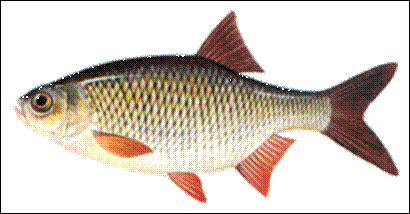|
"Your gateway to
understanding |
Eurasian rudd
click for full size
• Established population discovered in Oneida Lake in 1990
• Likely introduced to Oneida Lake as a baitfish
• Bright red fins make it easy to identify
Rudd, commonly known as redeye or pearl loach, are freshwater fish that are native to Eurasia. They were initially brought to the United States in the late 1800s or early 1900s for use as a baitfish. How and when rudd arrived in Oneida Lake is not known, but they were likely a bait bucket introduction.
Rudd are a stocky, broad-bodied fish with a forked tail. Their bodies range from silver-gray to olive to orange with bright red-orange fins. Eyes range in color from pink to gold. In native habitats, rudd can grow to 14 inches, may weigh as much as 4 pounds, and can live up to 15 years. Abundance of rudd in Oneida Lake is low, and they are observed infrequently.
Rudd can be found in lakes, rivers, marshes, canals and ponds. They prefer weedy habitats and have the potential to become a nuisance due to their consumption of aquatic plants. Despite this fact, rudd are largely carnivorous, feeding on aquatic crustaceans, snails and insects. Larger individuals will consume small fish, worms, and aquatic plants. Rudd can negatively affect spawning areas for other fish species through their consumption of plants. Another negative effect rudd have is hybridization with golden shiner, resulting in "genetic pollution."
To learn more about Eurasian rudd ...

